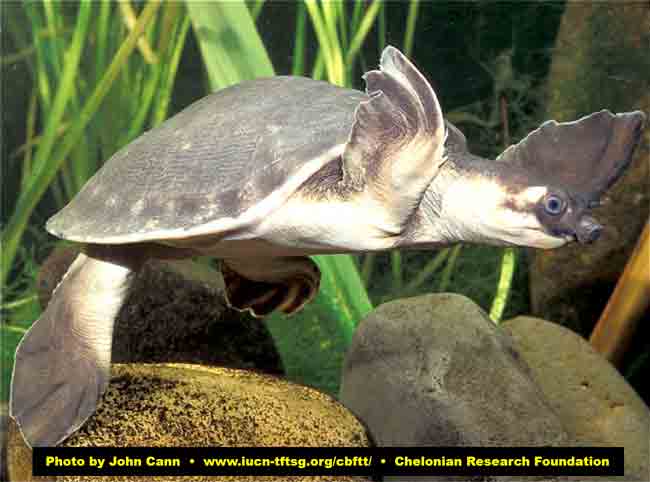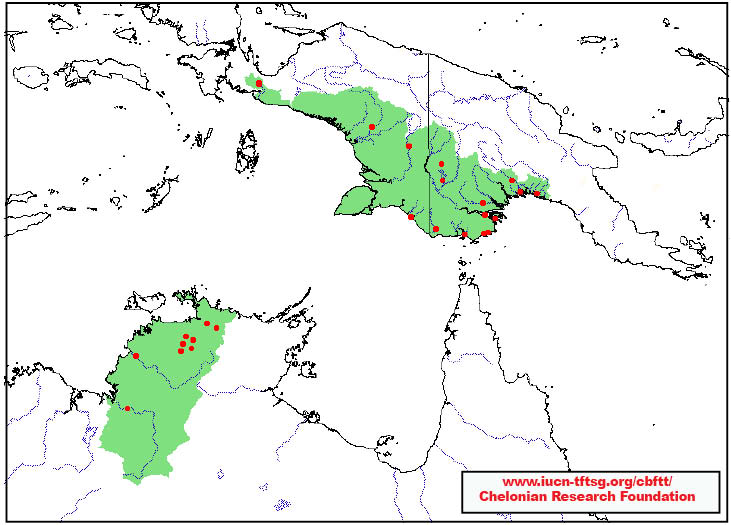Carettochelys insculpta, 009
Carettochelys insculpta Ramsay 1886 –
Pig-Nosed Turtle, Fly River Turtle
Arthur Georges1, J. Sean Doody1,
Carla Eisemberg1, Erika A. Alacs1, and Mark Rose2
1Institute for Applied Ecology, University of Canberra, ACT 2601, Australia
[[email protected]; [email protected];
[email protected]; [email protected]];
2Fauna and Flora International, Jupiter House, 4th Floor, Station Road,
Cambridge, CB1 2JD United Kingdom [[email protected]]
Summary. – Carettochelys insculpta, the pig-nosed turtle (Family Carettochelyidae), is the sole surviving member of a family of turtles that was widely distributed during the Tertiary. It is restricted to the southern rivers of New Guinea and the rivers of the Northern Territory in Australia. Carettochelys is therefore a distinctive geographic and taxonomic relict and, although locally abundant, it is rare in the sense of being geographically restricted. Moreover, Carettochelys is unique or unusual among turtles in many facets of its morphology, ecology, and behavior. Populations in New Guinea are thought to be declining because of increased exploitation for meat and eggs for both domestic consumption and the international pet trade. This exploitation has been exacerbated in recent times by the introduction of modern technology, principally outboard motors. In addition, clan warfare has ceased, and people have moved from the hinterland to more convenient locations along river banks. Moreover, levels of commercial activity such as logging, mining and exploration for oil, gold, and copper and fishing have increased in recent times, bringing larger human populations, both indigenous and non-indigenous, into closer contact with turtle populations. In Australia, feral animals have posed a threat through widespread trampling of nesting banks and destruction of riparian habitat. Other potential pressures include aggressive pastoral and agricultural practices that push the land in the important catchments beyond capability. Such agricultural development, if not accompanied by appropriate and effective land management, can result in erosion, destruction of riparian vegetation, siltation of water courses, reduction and altered timing and duration of dry season environmental flows, which can lead to gross degradation of riverine habitat as we have seen in the southern states of Australia. Urgent research is required to determine trends in population numbers and levels of exploitation in New Guinea, and to identify and implement management options for the sustainable exploitation of Carettochelys. In Australia, improved knowledge of the distribution of Carettochelys is required, especially the status of populations in the Victoria River, so that the value of the two known major populations in the Daly River and Alligator Rivers region can be adequately assessed. Wet-season habitat requirements, extent of seasonal movements, and requirements of juveniles are unknown, yet this information is needed to gauge the possible impact of proposed or potential development within catchments and to gauge the adequacy of existing reserves for protecting the species.
Distribution. – Australia, Indonesia, Papua New Guinea. Distributed in the southern lowlands of Indonesian Papua and Papua New Guinea, and northwestern Northern Territory, Australia.
Synonymy. – Carettochelys insculptus Ramsay 1886, Carettochelys insculpta, Carettochelys insculpta insculpta, Carettochelys insculpta canni Wells 2002.
Subspecies. – None currently recognized. The subspecific designation by Wells (2002) does not constitute a publication for the purposes of nomenclature, and adequate differentiation of the New Guinean and Australian populations as subspecies has not been presented.
Status. – IUCN 2007 Red List: Vulnerable (VU A1bd) (assessed 2000); CITES: Appendix II; Australian EPBC Act: Not Listed; Northern Territory PWC Act: Near Threatened.
Citation:
Georges, A., Doody, J.S., Eisemberg, C., Alacs, E.A., and Rose, M. 2008. Carettochelys insculpta Ramsay 1886 – pig-nosed turtle, Fly River turtle. In: Rhodin, A.G.J., Pritchard, P.C.H., van Dijk, P.P., Saumure, R.A., Buhlmann, K.A., and Iverson, J.B. (Eds.). Conservation Biology of Freshwater Turtles and Tortoises: A Compilation Project of the IUCN/SSC Tortoise and Freshwater Turtle Specialist Group. Chelonian Research Monographs No. 5, pp. 009.1-009.17, doi:10.3854/crm.5.009.insculpta.v1.2008, //iucn-tftsg.org/cbftt.
(Adobe Acrobat 6.0 or later required)

Subadult female Carettochelys insculpta
, Daly River, Northern Territory, Australia.
Photo by John Cann.
Distribution:

Distribution of Carettochelys insculpta in southern Indonesian Papua and Papua New Guinea, and northwestern Northern Territory in Australia. Red points = museum and literature occurrence records based on published records plus more recent and authors’ data; green shading = projected distribution based on GIS-defined hydrologic unit compartments (HUCs) constructed around verified localities and then adding HUCs that connect known point localities in the same watershed or physiographic region, and similar habitats and elevations as verified HUCs (Buhlmann et al., unpubl. data), and adjusted based on authors’ data.








